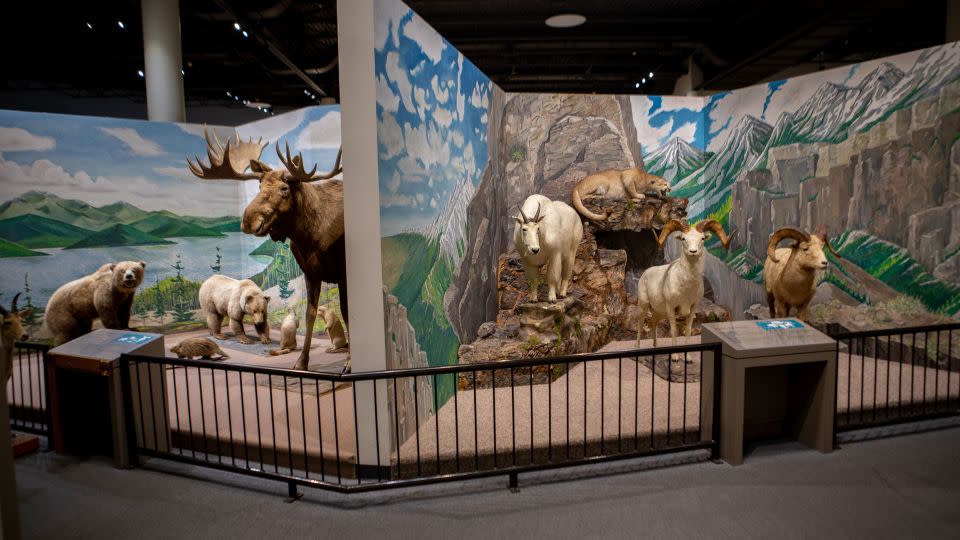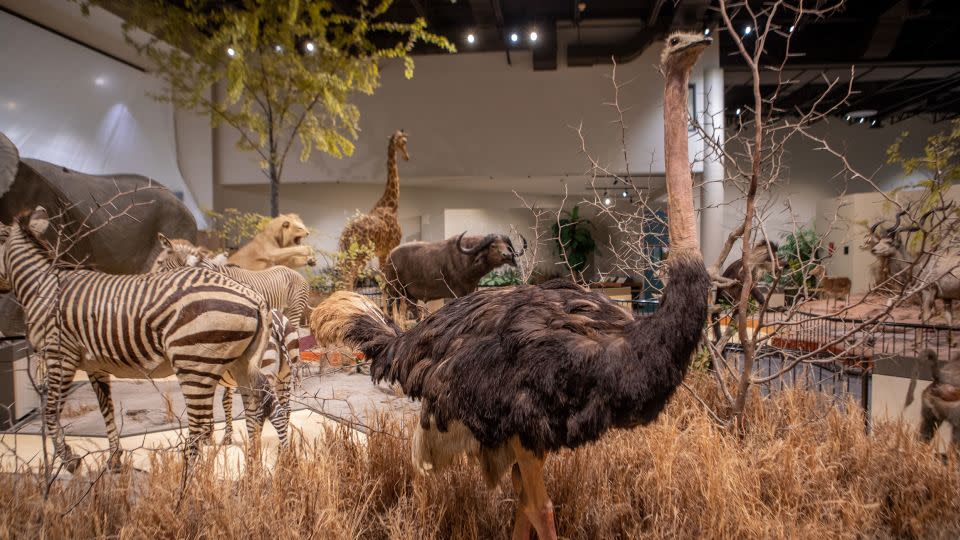More than 130 taxidermied animals in a South Dakota museum were found to contain arsenic. Nobody knows what to do with them
What do you do with more than 130 arsenic-tinged taxidermied animals with significant historical and academic value, languishing in a now-closed museum that may or may not be a public health hazard?
When the city of Sioux Falls, South Dakota, makes a decision, they’ll let you know.
The extensive collection of decades-old preserved animals at the Great Plains Zoo’s shuttered Delbridge Museum has been a source of drama since August, when tests on the aging specimens turned up various levels of arsenic – a carcinogenic chemical that was a common ingredient in animal preservation throughout much of the 20th century.
The museum was promptly shut down to the public, but debates about the fate of the animals rage on outside the silent menagerie’s closed doors. The city’s Facebook pages have been peppered with comments, from residents upset at being potentially exposed to arsenic to others urging the city not to destroy the taxidermy collection.
Said Sioux Falls mayor Paul TenHaken at a recent press conference, “There’s a lot of emotion around this topic.”
The city is weighing its options
The city of Sioux Falls owns the roughly 170-piece collection, which includes a majestic elephant, walruses, ungulates of every size and even a panda that was a fellowship gift from China.
At a press conference last month, Great Plains Zoo CEO Becky Dewitz said a recent examination of the museum’s taxidermy collection revealed that 79% of the specimens contained detectable levels of arsenic.
“The specimens were harvested at a time … in the late 1940s, when arsenic, asbestos and other chemicals were readily used in taxidermy,” Dewitz said, adding that she doesn’t believe the animals posed a health risk to visitors. “We have proper precautions in place, with barriers, ‘Do not touch’ signs, and I do not believe the public was in jeopardy.”
But that doesn’t answer the question of what the city should do with the animals.
Donate them? Get rid of them altogether? How do you “get rid” of a 40-year-old diorama of mountain goats?
Museum preservation groups have urged the city to take care with the specimens, which are considered by enthusiasts to be works of art and have historically served as important tools of public education.
All of these issues came together this month when TenHaken, the mayor, announced a working group to decide the fate of the menagerie. The group consists of city officials, zoo leaders, and various experts in natural history and preservation.
“When we have a known carcinogen in one of our public displays, we can’t take risks,” TenHaken said at a press conference concerning the museum’s fate.
Arsenic has been prohibited for use in museum preservation since the 1980s. Before that, it was used to prevent pests and decay. Exposure to arsenic can damage the skin, eyes and vital organs, and is known to cause cancer.
TenHaken’s plan is to have the collection legally declared “surplus,” allowing the city to get the animals out of the museum. But where to put them is not so simple. The Delbridge menagerie has a lot of history, and there’s legal red tape – according to state law, such artifacts cannot be destroyed or sold privately. They can only be donated to responsible organizations within South Dakota for display or storage.

Several of the animals on display are critically endangered or otherwise protected, which makes their fate a national question. The Endangered Species Act has specific restrictions for how certain animals – even when they’re dead and stuffed – can be be transferred between parties.
CNN has reached out to the mayor’s office and to zoo leadership for comment. Both groups declined to provide further details while the matter is still under the working group’s consideration.
The working group is expected to present a plan to the city by the end of the year.
Decades of history are on the line
A majority of the collection’s animals were acquired by a Sioux Falls businessman named Henry Brockhouse on hunting expeditions between the 1940s and 1970s. After his death, they were purchased at auction by area attorney C.J. Delbridge in 1981. He donated the collection to the city, and it has been housed at the Great Plains Zoo since 1984.
One zoo official described the arrangement to CNN as “mutually beneficial” for the city. The collection found a home, while the zoo acquired a unique and popular attraction.
The Great Plains Zoo, which included the Delbridge Museum when it was open, attracts about 250,000 visitors a year.
But Dewitz acknowledged at a press conference last month that the museum and its exhibits were in need of a refresh.
“It is showing its signs of age, and the specimens are cracking and some look very tired,” she said.
When the museum’s closure was announced in August, Dewitz expressed regret.
“It’s sad,” Dewitz told KELO, a local news outlet. “We just have such appreciation to the (Delbridge) family for the educational value this provided to our community.”
Dewitz said the museum was closed as a “proactive” measure to protect the specimens from further degradation, which could mean more chemical exposure.
Experts say taxidermy can offer scientific value
The saga of the Delbridge menagerie has attracted a lot of attention, because it’s not every day a city must divest itself of scores of antique pieces of taxidermy. However, taxidermists and museum preservationists stress that the collection isn’t just an array of trophies hunted and stuffed by a jet-setting businessman.
“Taxidermy satisfies a natural curiosity, allowing people to encounter and connect with animals up close,” Paloma Strong, a taxidermist at the award-winning Los Angeles studio Prey Taxidermy, told CNN.
“This closeness fosters a deeper appreciation for species, fostering a sense of responsibility towards conservation of endangered or cryptic species. In an era where many feel disconnected from nature, taxidermy becomes a bridge, rekindling the human-nature connection and nurturing a renewed interest in wildlife.”

The Society for the Preservation of Natural History Collections released a statement specifically addressing the Delbridge Museum’s closure. The group said the risks of preservation – like decay over time, or chemicals used in the process – are complex and possible to reduce with “known protocols and procedures.”
“The decision to disassemble exhibitions, dispose of historic and scientifically valuable taxidermy mounts, and move mounts of endangered species from public display to closed storage rooms should not be based on the composition of the objects,” the SPNHC’s statement concluded.
There are some options to preserve and display taxidermy mounts even if they do contain arsenic. According to information from the Indiana Historical Society, such pieces could be displayed behind glass or re-treated to remove arsenic.
A Great Plains Zoo official told CNN proper display of the animals was a condition of the original donation. While the animals were not behind glass, all of the taxidermy exhibits had railings to keep the public at a distance.
Strong said there is value in trying to restore historic animal specimens, if possible, but new taxidermy technology is safer and longer-lasting. If specimens have deteriorated, it may be best to start from scratch, she said.
Scientific curiosity has been a draw of taxidermy since the practice became popular in the 19th century, as was the hobby of hunting and preserving one’s own collection, like Brockhouse did.
Such work is also important for scientific research, and can provide tangible specimens, DNA samples and other data for observation. (Cool fact: Naturalist Charles Darwin learned the art of taxidermy from a man named John Edmonstone, a former enslaved person from Guyana who eventually settled in Scotland.)
“Taxidermy offers a unique perspective, showcasing animals in their dynamic, natural state — revealing form, motion, and habitat,” Strong said. “The craft preserves colors lost post-mortem, enhancing our understanding beyond flat specimens.”
Even in modern times, a museum diorama or well-preserved rare specimen might be the only chance a regular person gets to see certain animals in the (preserved) flesh.
While taxidermy has experienced somewhat of a cottage resurgence in recent years, several museums have altered or moved their collections. In an age of interactive digital displays, museums are searching for new ways to pique visitor’s imaginations about the natural world.
For more CNN news and newsletters create an account at CNN.com

